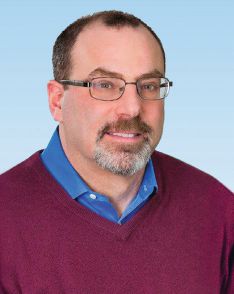Change Leader: Changing Practices for a Changing World
This particular webcam interview was recorded by Todd Danielson, the editorial director of Informed Infrastructure.
These profiles are based on interviews, and the opinions and statements are those of the subject and are not necessarily shared or endorsed by this publication.

Michael Mondshine
Professional-services consultancy WSP USA introduced a new Climate, Resilience and Sustainability (CRS) business line to help solve the dynamic challenges of equitable climate mitigation, asset and infrastructure adaptation, and emergency management. Leading the new division are Tom Lewis and Michael Mondshine.
Lewis describes CRS as having four legs to its stool: Environmental, Social and Corporate Governance (ESG); Sustainability; Community/Infrastructure Resilience; and Emergency/Disaster Response. He adds that what separates WSP’s CRS division from other engineering firms’ sustainability efforts are the company’s “Future Ready” approach to helping clients solve for these challenges, as well as its breadth of services and skillsets.
A Sea Change
According to Mondshine, the last three years or so have seen dramatic changes in public and business perceptions of sustainability.
“Historically, there’s been a notion that sustainability was a cost, that resilience was a cost,” he notes. “But now we’ve learned that it’s really central to the business model of companies, and it’s central to the mission of public agencies. We’ve also seen a sea change in the notion of social equity and how we handle that as it relates to infrastructure and the environment.
“Right now is the moment we need to meet to put together this new climate, resilience and sustainability team,” Mondshine adds. “Folks need a holistic approach that starts on the front end from sustainable planning and then requires you to pass your skills off to engineering.”
According to Lewis, WSP USA is especially prepared for changing climate conditions due to its long history in emergency management.
“We try to bring together our boots-on-the-ground experience from long-term large-disaster experiences, both in the initial phase of immediate response and then in the long recoveries that occur after major disasters,” says Lewis.
Lasting Infrastructure Amid Rapid Change
Mondshine points out that demographics, technology and climate are all rapidly changing, but infrastructure is built to be in place for many decades.
“We need to be thinking ‘how is the infrastructure we design and build today going to provide service to people in an equitable fashion?’” he says. “Not just today, not just 10 years from now, but 40 or 50 years from now. And that’s not just about complying with code, that’s thinking in a sustainable and resilient fashion.”
Removing Stovepipes
According to Mondshine, commercial and public-sector infrastructure are too often looked at separately, and that’s a major mistake as most of the risk in the private sector from a changing climate and environment is in public infrastructure: the roads for people to get to work as well as the electricity and water they depend upon for businesses to run.
“On the flip side, these commercial entities have invaluable insights they can provide governments and public entities,” he adds. “Quite often, some of the key resilience elements for public entities are operated by the private sector. The partnership between the two, the experience we can leverage from both ends, gets us to a ‘one plus one equals three’ situation.”
What CRS Looks Like
In terms of practical applications of how the new division will work with customers, WSP USA often starts with gap analyses and benchmarking to see where clients fit and where they need improvement. Then it looks at expectations of key stakeholders, investors, employees, NGOs and constituents for public agencies. Then it focuses on community engagement.
“I think there’s this perception that infrastructure is about steel and concrete, but it turns out it’s really about people,” notes Mondshine. “It’s about the services and utility infrastructure can deliver to people.”
About Todd Danielson
Todd Danielson has been in trade technology media for more than 20 years, now the editorial director for V1 Media and all of its publications: Informed Infrastructure, Earth Imaging Journal, Sensors & Systems, Asian Surveying & Mapping, and the video news portal GeoSpatial Stream.


